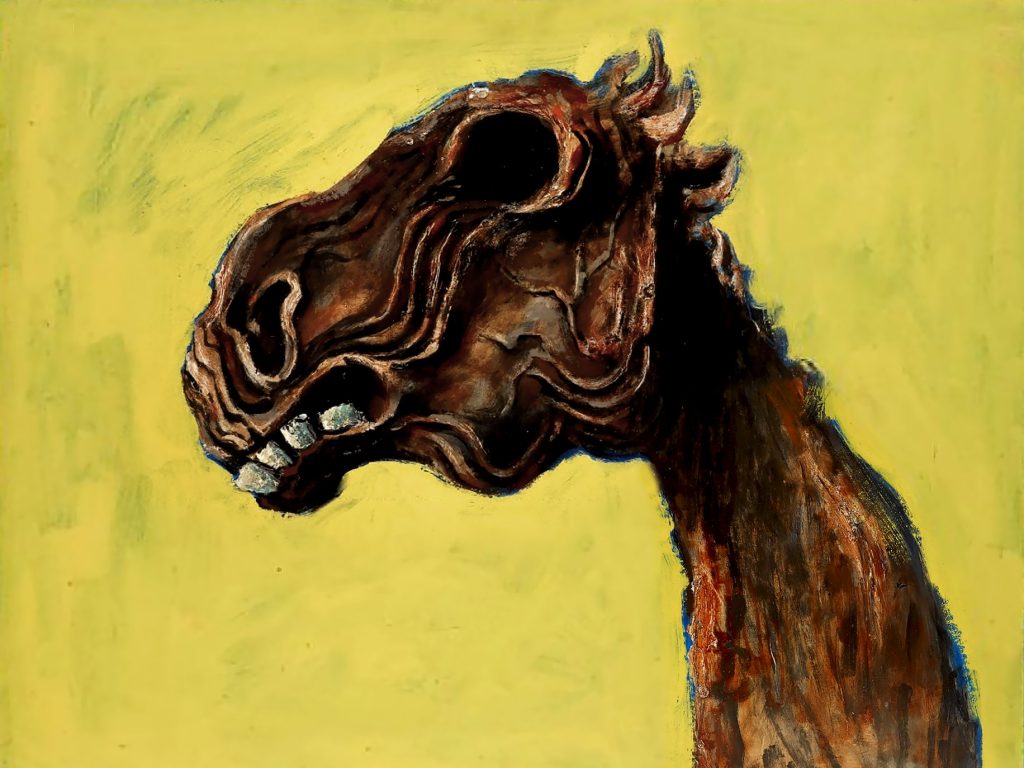Painting is a visual language and doesn’t need an explanation. Artists call on all their years of experience, conflict, disappointment, loves and obsessions to create a mood, a feeling that words can’t replace.
It’s not necessary to know how the artist arrived at the work, or what was in their mind. Your job as a viewer is just to look – allow the image to wash over you. In my mind the first impact is the most important, where your unfettered emotions work the strongest. It’s the purest connection between you and the artist. So never think a learned art critic is any better equipped than you or anyone else at taking in the artist’s emotion and message.
Talking of first impact, let me tell you about the two paintings by Albert Tucker I saw on my last two visits to Heide Art Gallery.
Last Friday I was taken aback by Albert Tucker’s confronting painting Apocalyptic Horse, 1956. It exploded with powerful emotion. What a shock –– which immediately drenched me in horror and sorrow. The head of this dead horse, burnt dry by the sun and time on a sky mimicking yellow desert; embalmed in its own leather skin. Shrunken into almost a skeleton with cavernous empty pits for eyes and grotesque teeth barely staying in the skull.
I know this horse must have died from lack of food or water and was part of the perils of an Australian outback drought. Tucker is so skilful with his trademark deeply gouged furrows and wrinkled skin, as to leave no doubt in the viewer’s mind that what was once a beautiful shiny – skin’d steed, had met with disaster, and time had worn it away even more.
Apocalyptic Horse reminded me so much of Tucker’s portrait (of) Sunday Reed,1984 I saw at Heide a couple of months ago. The same shock, horror, sadness and disaster.
61 x 76 cm, Oil on composition board
Gift of Barbara Tucker 1999
Courtesy of Sotheby’s Australia
Why is every portrait of Sunday Reed so ravaged with time, so savage and mean-looking, especially when compared to the dozens he painted of friends: Arthur Boyd, Sidney Nolan, John Perceval, Joy Hester and Danila Vasilieff etc. At first glance, that first impact makes her appear in the throes of death, only just alive, and decaying in her own skin. Like the horse, her teeth too, are twisted, loose: protruding skeleton-like from receding gums, her flesh also deeply furrowed, withered and dried over time.
Tucker emphasises the mood with his treatment of her arm and wrist: it’s not human. It’s the bone of a dead horse or cow, covered in stretched dried leather.
The similarities between these two paintings is no accident. One explanation could stem from Tucker’s deep and lasting friendship with Sidney Nolan, and Nolan’s falling out with the Reeds.
Tucker and Nolan collaborated on exhibitions and spent a lot of time supporting each other away from Australia – in fact, Apocalyptic Horse was inspired by a photograph of a dead horse taken by Sidney Nolan in 1952 called Brian the Stockman at Wave Hill Mounting Dead Horse, and given to Tucker by Nolan in London. They were both original members of the Heide group in the 1940s along with Tucker’s then wife, Joy Hester. I have read and been informed by many friends of Albert Tucker how upset he was when the Reeds refused to give Nolan back his Ned Kelly series. Part of the Reed’s claim was that Sunday had a hand in creating them, and that they had supported Sidney Nolan during that time. Possibly Tucker is expressing his disdain for Sunday Reed’s degradation of generosity and maybe even of moral values over time.
What also convinces me this could have been Tucker’s approach is his treatment of the fireplace. It hasn’t got a warm satisfying yellow flame glow, but more a deep red menacing hellish appearance. And like a trophy sitting on the mantlepiece, Tucker has placed one of his Modern Evil sculptures.
Of course, others may see his portrait of Sunday Reed in a completely different light than mine, but she certainly doesn’t appear as a warm-hearted generous supporter of artists, as she no doubt was in her younger years …before the ravages of time, and whatever else occurred.
Hero Image (Top):
Albert Tucker, Apocalyptic Horse, 1956
62 x 81cm, Oil on hardboard
Art Gallery of New South Wales, Sydney, Purchased 1982
© Albert & Barbara Tucker Foundation
Courtesy of Sotheby’s Australia
APOCALYPTIC HORSE
Until 15 September 2019
Heide III: Albert & Barbara Tucker Gallery
Heide Museum of Modern Art
7 Templestowe Rd, Bulleen, Victoria
Tel 03 9850 1500
heide.com.au



Comments are closed.